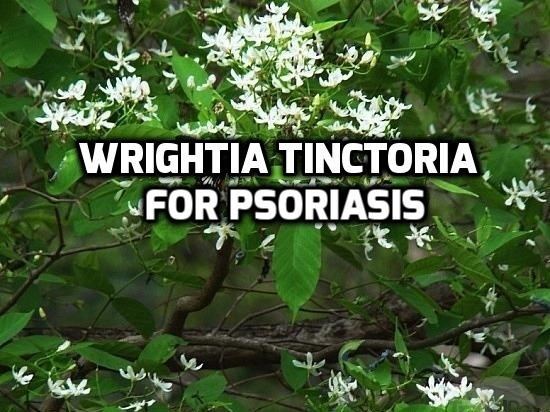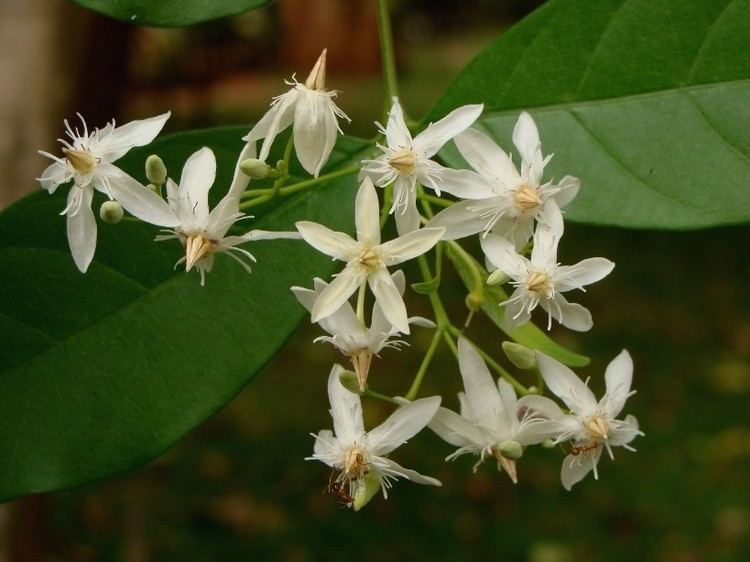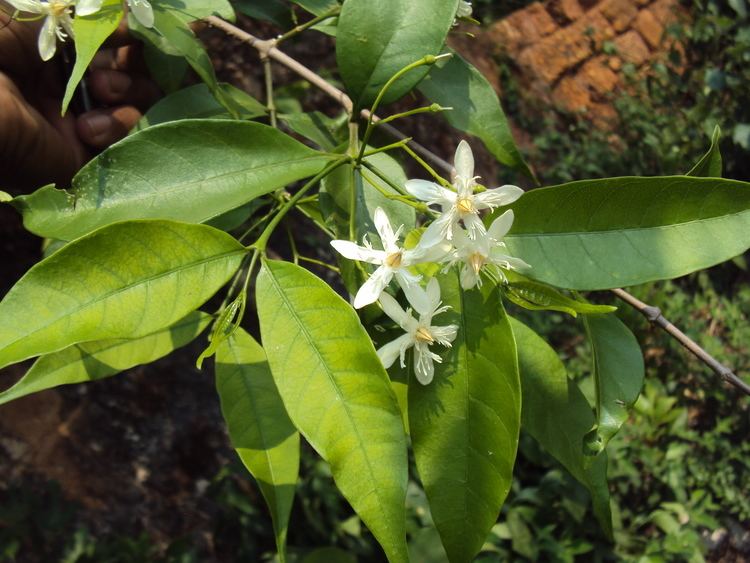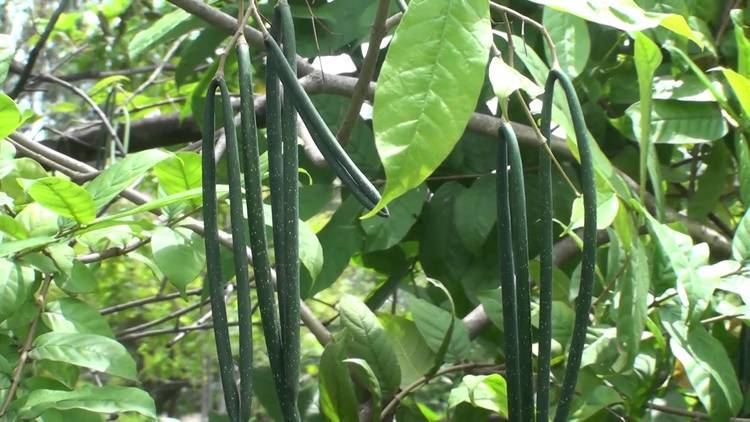Genus Wrightia Rank Species | ||
 | ||
Similar Wrightia, Wrightia antidysenterica, Apocynaceae, Anogeissus latifolia, Helicteres isora | ||
Sweet indrajao wrightia tinctoria
Wrightia tinctoria, Pala indigo plant or dyers’s oleander, (Malayalam : ദന്തപ്പാല) is a flowering plant species in the genus Wrightia found in India, southeast Asia and Australia. It is found in dry and moist regions in its distribution. Various parts of the plant have medicinal properties.
Contents
- Sweet indrajao wrightia tinctoria
- Wrightia tinctoria fruit pods
- Morphology
- Phytochemistry
- Taxonomy
- Distribution and habitat
- Ecology
- Uses
- Medicinal uses
- References

Wrightia tinctoria fruit pods
Morphology

It is a small to medium sized deciduous shrub or tree, ranging from 3 m to 15 m in height but also reaching up to 18 m. The bark is smooth, yellowish-brown and about 10 mm thick, producing a milky-white latex. Leaves are simple, oppositely arranged, ovate, obtusely acuminate and are 10–20 cm long and 5 cm wide. Leaves are glabrous and sometimes pubescent beneath. Leaf stalks are very short. The flowers appear (in India) from March to May, peaking from April to June. White flowers appear in corymb-like cymes, 5–15 cm across, at the end of branches. Flowers have five white petals 2–3 cm long which turn creamish yellow as they age. The flowers have oblong petals which are rounded at the tip, and are similar to flowers of frangipani. Fruiting is in August and the fruit is cylindrical, blackish-green speckled with white, long horn-like and united at tip. The seeds are brown and flat with bunch of white hairs. Seed dispersal is by wind and pollination is by insects. In his 1862 book on timber trees of South Asia, Edward Balfour mentions its distribution across the then Madras Presidency of British India especially in the Coimbatore jungles, and reports that it was "very common in all forests of Bombay". In the same book, Balfour quotes William Roxburgh's comparison of the whiteness of the wood as "coming nearer to ivory than any I know". Earlier in 1824, the plant specimens were presented by the British East India Company to the Royal Horticultural Society as illustrated and recorded in botanical register founded by Sydenham Edwards and at the time published by James Ridgway.
Phytochemistry

The plant contains wrightial, a triterpenoid chemical, along with cycloartenone, cycloeucalenol, β-amyrin, and β-sitosterol isolated from the methanol extract of the immature seed pods.
Taxonomy
The following are considered to be synonyms of Wrightia tinctoria:

Distribution and habitat
It is mainly found in Australia, India, Myanmar, Nepal, Timor and Vietnam. Within India, it is found in most of the peninsular and central India except the northern and north-eastern states.
Ecology
It is a slow to moderate-growing plant. Plants commence flowering when about 5 - 8 years old. It grows in a wide range of soil types ranging from arid, semi-arid, gravely or rocky soils and moist regions, especially on dry sandy sites or hillsides and valleys. The tree responds well to coppicing, and also produces root suckers. It tolerates moderate shading and is often found as undergrowth in deciduous forests. It also tolerates high uranium levels in soils. In India, the fungus Cercospora wrightia is known to cause leaf spot disease of Wrightia tinctoria.
Uses
The flowers, leaves, fruits and seeds are edible. The tree is harvested from the wild as a medicine and source of a dye and wood. Leaves are extracted as fodder for livestock. The leaves, flowers, fruits and roots are sources of indigo-yielding glucoside, which produces a blue dye or indigo- like dye. About 100 - 200 kilos of leaves are needed to prepare 1 kilo of dye. It is occasionally planted as an ornamental in the tropics. The branches are trampled into the puddle soil in rice field for green manuring. It is recommended as a good agroforestry species as it intercrops well. The wood of Wrightia tinctoria is used extensively in India for carving and lacquer work for toys. The timber is high in quality and valuable. The white wood, which is very fine, is used for turnery, carving, toy making, matchboxes, small boxes and furniture. High levels of extraction is resulting in it becoming scarce in some regions. The famous Channapatna toys are made from its wood. The sap added to milk has been reported to have preservative properties; the milk will remain fresh for some time, the taste remaining unaltered.
Medicinal uses
It is a medicinal plant in Ayurveda described in classical Ayurvedic texts as Shwetha kutaja and seeds known as Indrayava. It is also known from Unani and Siddha systems as Inderjao shireen and Irum-paalai respectively. According to Ayurveda, the bark is useful in treatment of diarrhoea, piles, ringworm and other skin diseases. Seeds also have anti-dysenteric properties and are also used as astringents, antihelminthics, aphrodisiacs and to reduce fevers. Laddus made of baked seeds has been described as a remedy for improving libido. Bark and seeds are used to treat flatulence. Root bark extract is used orally as an antidote for snakebite. Powder of the bark is also used for treatment of kidney stones. Its stem bark extract is used in animals for the treatment of Anthrax. The oil we get after the leaves are exposed in sunlight in pure coconut oil is good for scaly and itching scalp and other parts of body.
